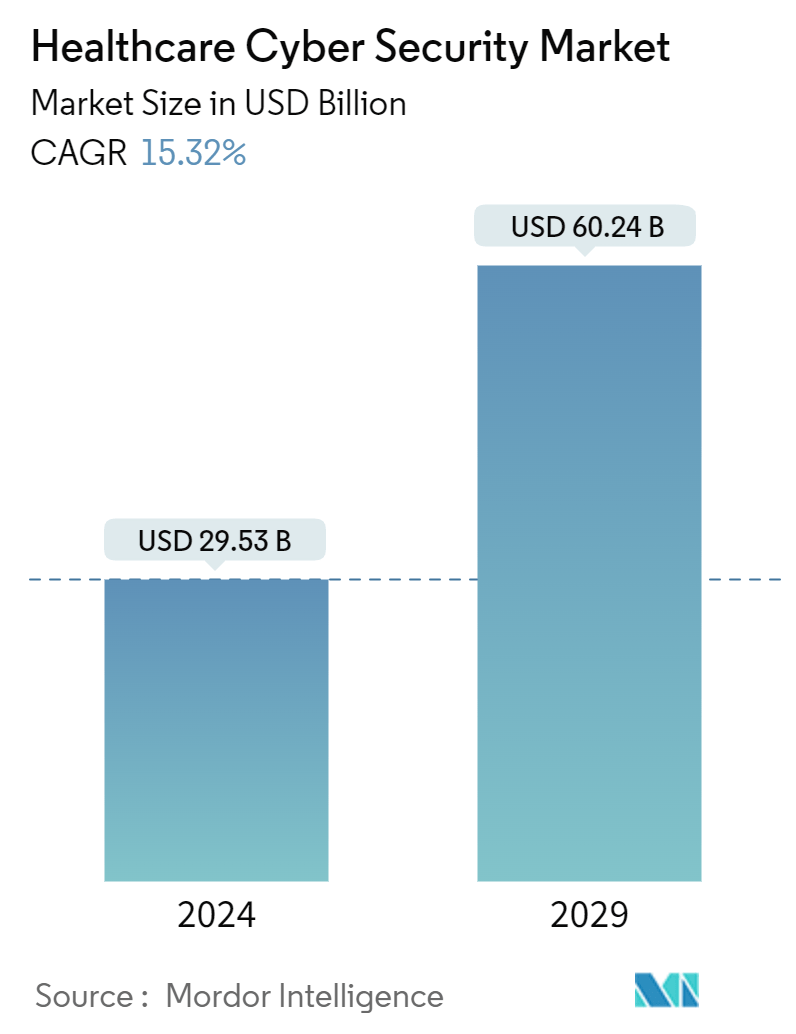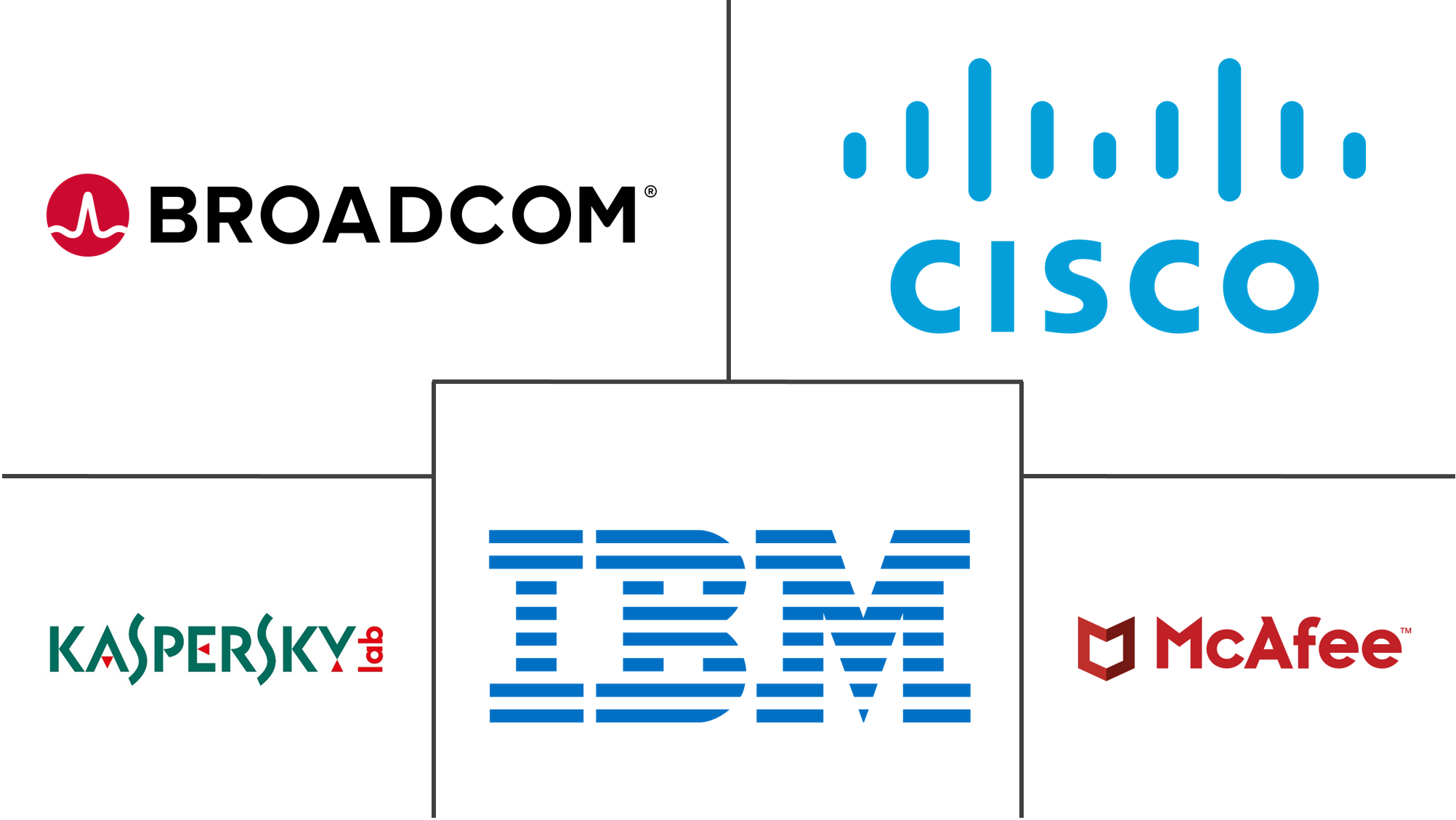Market Size of Healthcare Cyber Security Industry

| Study Period | 2019 - 2029 |
| Market Size (2024) | USD 29.53 Billion |
| Market Size (2029) | USD 60.24 Billion |
| CAGR (2024 - 2029) | 15.32 % |
| Fastest Growing Market | Asia Pacific |
| Largest Market | North America |
Major Players
*Disclaimer: Major Players sorted in no particular order |
Healthcare Cyber Security Market Analysis
The Healthcare Cyber Security Market size is estimated at USD 29.53 billion in 2024, and is expected to reach USD 60.24 billion by 2029, growing at a CAGR of 15.32% during the forecast period (2024-2029).
- Escalating Cyber Threats Drive Healthcare Security Market: The Healthcare Cyber Security Market is experiencing significant growth, driven by an escalating wave of cyberattacks targeting the healthcare sector. Healthcare organizations face unprecedented risks, with ransomware attacks increasing by 755% in 2021. This surge in threats is forcing healthcare providers to bolster their cybersecurity infrastructure, safeguarding critical patient data and ensuring operational continuity.
- Cyberattack Impact: According to the IBM Cost of a Data Breach Report, healthcare had the highest average data breach cost, reaching $7.13 million in 2020.
- Widespread Incidents: The CyberPeace Institute recorded over 235 cyberattacks on healthcare organizations in 33 countries, resulting in the theft of more than 10 million patient records.
- High-Profile Attack: The ransomware attack on Ireland's Health Service Executive (HSE) in May 2021 highlights the sector’s vulnerability and urgent need for advanced protection.
- Cloud Adoption Accelerates Cybersecurity Demand: The rapid adoption of cloud services in healthcare is creating both challenges and opportunities in cybersecurity. Hybrid cloud solutions, which enhance operational efficiency and data analytics, are being embraced to manage costs. However, this shift increases the need for robust cybersecurity measures to protect sensitive patient information across diverse cloud platforms.
- Cloud Integration Growth: Nutanix projects that healthcare organizations will increase hybrid cloud deployments by 32 percentage points over the next five years.
- Strategic Partnerships: Major institutions like Cleveland Clinic are collaborating with tech companies such as IBM to harness hybrid cloud, AI, and quantum computing technologies.
- Guidelines for Cloud Security: The European Union Agency for Cybersecurity (ENISA) has released cloud security guidelines specifically for healthcare, underscoring the growing need for secure cloud infrastructures.
- Inadequate Security Infrastructure Poses Risks: A significant gap in healthcare information security infrastructure presents both risks and opportunities. Many healthcare organizations have limited cybersecurity training and outdated infrastructure, leaving them vulnerable to breaches. This gap is fueling demand for customized cybersecurity solutions designed to meet healthcare providers' unique needs.
- Training Gaps: NordLocker’s survey revealed that 56% of healthcare employees have not received any cybersecurity training from their current employers.
- Regional Disparities: In India, the adoption of Healthcare Information Technology (HIT) remains low compared to developed nations due to underfunding and limited IT expertise.
- Growing mHealth Market: The rapid growth of the mHealth market in India signals a pressing need for mobile-specific cybersecurity solutions as healthcare organizations adopt mobile technologies.
- Market Dynamics Shaped by Regulatory Pressures: Regulatory frameworks such as HIPAA in the U.S. are playing a pivotal role in driving the Healthcare Cyber Security Market. These regulations require strict data protection measures, compelling healthcare organizations to invest in compliant cybersecurity solutions.
- Data Breach Incidents: The U.S. Department of Health and Human Services reported that hacking incidents accounted for most data breaches involving 500+ patient records in 2021.
- EHR Systems: The increasing adoption of electronic health records (EHR) mandates robust security protocols to protect patient data.
- ROI-Driven Adoption: Vendors are focusing on demonstrating a return on investment (ROI) by improving the efficiency of cybersecurity systems, which is crucial for overcoming implementation barriers.
- Emerging Technologies Reshape Security Landscape: The rise of Internet of Things (IoT) devices and artificial intelligence (AI) in healthcare is introducing new cybersecurity challenges. These technologies increase the attack surface and demand specialized security solutions, prompting vendors to develop AI-powered tools and IoT-specific protection.
- IoT Device Risks: A 2022 report revealed that one-third of bedside IoT devices in healthcare have critical vulnerabilities that could be exploited by cybercriminals.
- AI Integration: The U.S. Department of Health and Human Services is using AI-powered SaaS tools for tasks such as grant application analysis, showing the growing role of AI in healthcare operations.
- Medical Device Security: Cybersecurity companies are creating solutions that safeguard the increasingly interconnected ecosystem of medical devices and data systems, addressing the evolving healthcare threat landscape.
Healthcare Cyber Security Industry Segmentation
Healthcare cyber security, also known as information technology security or computer security, is a body of technologies, processes, and practices designed to protect networks, computers, programs, and data related to healthcare from unauthorized access and damage or attack.
The healthcare cyber security market is segmented by type of threat (malware, distributed denial of service (DDOS), advanced persistent threats (APT), spyware), by type of solution (identity and access management, risk and compliance management, antivirus and antimalware, security information and event management, intrusion detection system (IDS)/intrusion, prevention system (IPS)), by end user (pharmaceuticals and biotechnology, health insurance, hospitals), by geography (North America (United States, Canada, Mexico), Europe (France, Germany, United Kingdom, Italy, Spain, rest of Europe), Asia Pacific (China, Japan, India, Australia and New Zealand, South Korea, rest of Asia Pacific), Latin America (Brazil, Argentina, rest of Latin America), Middle East and Africa (GCC, South Africa, rest of Middle East and Africa)). The market sizes and forecasts are provided in terms of value in USD for all the above segments.
| By Type of Threat | |
| Malware | |
| Distributed Denial of Service (DDoS) | |
| Advanced Persistent Threats (APT) | |
| Spyware | |
| Other Type of Threats |
| By Type of Solution | |
| Identity and Access Management | |
| Risk and Compliance Management | |
| Antivirus and Antimalware | |
| Security Information and Event Management | |
| Intrusion Detection System (IDS)/Intrusion Prevention System (IPS) | |
| Other Type of Solutions |
| By End User | |
| Pharmaceuticals and Biotechnology | |
| Health Insurance | |
| Hospitals | |
| Other End Users |
| By Geography | ||||||||
| ||||||||
| ||||||||
| ||||||||
| ||||||||
|
Healthcare Cyber Security Market Size Summary
The healthcare cybersecurity market is experiencing significant growth, driven by the increasing frequency and sophistication of cyber-attacks targeting healthcare institutions. As the industry undergoes digital transformation, the need for robust cybersecurity solutions to protect sensitive patient data has become paramount. The proliferation of connected technologies, such as the Internet of Medical Things (IoMT) devices, has enhanced patient care but also introduced new vulnerabilities. The demand for cloud-based cybersecurity services is rising, fueled by the low penetration of information security systems and the need to safeguard electronic health records, which are prime targets for attackers. Despite these challenges, a lack of awareness and dedicated cybersecurity policies in some healthcare organizations poses a barrier to market expansion.
North America leads the healthcare cybersecurity market, supported by a well-developed healthcare infrastructure, high investment in healthcare IT, and stringent government regulations like HIPAA. The region's market growth is further bolstered by the increasing adoption of cloud-based security solutions and the expanding use of IoT devices. The COVID-19 pandemic has also accelerated the demand for cybersecurity services, as cyberattacks on healthcare systems surged. The market is moderately competitive, with major players investing in research and development, strategic partnerships, and acquisitions to enhance their offerings. Companies like Clearwater, IBM, and Fortinet are actively expanding their capabilities to address the evolving cybersecurity landscape in healthcare.
Healthcare Cyber Security Market Size - Table of Contents
-
1. MARKET INSIGHTS
-
1.1 Market Overview
-
1.2 Industry Attractiveness - Porter's Five Forces Analysis
-
1.2.1 Threat of New Entrants
-
1.2.2 Bargaining Power of Buyers
-
1.2.3 Bargaining Power of Suppliers
-
1.2.4 Threat of Substitute Products
-
1.2.5 Intensity of Competitive Rivalry
-
-
1.3 Assessment of the Impact of COVID-19 on the Market
-
-
2. MARKET SEGMENTATION
-
2.1 By Type of Threat
-
2.1.1 Malware
-
2.1.2 Distributed Denial of Service (DDoS)
-
2.1.3 Advanced Persistent Threats (APT)
-
2.1.4 Spyware
-
2.1.5 Other Type of Threats
-
-
2.2 By Type of Solution
-
2.2.1 Identity and Access Management
-
2.2.2 Risk and Compliance Management
-
2.2.3 Antivirus and Antimalware
-
2.2.4 Security Information and Event Management
-
2.2.5 Intrusion Detection System (IDS)/Intrusion Prevention System (IPS)
-
2.2.6 Other Type of Solutions
-
-
2.3 By End User
-
2.3.1 Pharmaceuticals and Biotechnology
-
2.3.2 Health Insurance
-
2.3.3 Hospitals
-
2.3.4 Other End Users
-
-
2.4 By Geography
-
2.4.1 North America
-
2.4.1.1 United States
-
2.4.1.2 Canada
-
2.4.1.3 Mexico
-
-
2.4.2 Europe
-
2.4.2.1 France
-
2.4.2.2 Germany
-
2.4.2.3 United Kingdom
-
2.4.2.4 Italy
-
2.4.2.5 Spain
-
2.4.2.6 Rest of Europe
-
-
2.4.3 Asia Pacific
-
2.4.3.1 China
-
2.4.3.2 Japan
-
2.4.3.3 India
-
2.4.3.4 Australia and New Zealand
-
2.4.3.5 South Korea
-
2.4.3.6 Rest of Asia Pacific
-
-
2.4.4 Latin America
-
2.4.4.1 Brazil
-
2.4.4.2 Argentina
-
2.4.4.3 Rest of Latin America
-
-
2.4.5 Middle East and Africa
-
2.4.5.1 GCC
-
2.4.5.2 South Africa
-
2.4.5.3 Rest of Middle East and Africa
-
-
-
Healthcare Cyber Security Market Size FAQs
How big is the Healthcare Cyber Security Market?
The Healthcare Cyber Security Market size is expected to reach USD 29.53 billion in 2024 and grow at a CAGR of 15.32% to reach USD 60.24 billion by 2029.
What is the current Healthcare Cyber Security Market size?
In 2024, the Healthcare Cyber Security Market size is expected to reach USD 29.53 billion.

